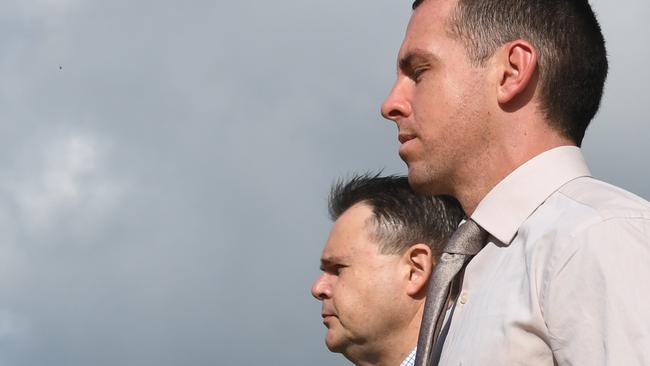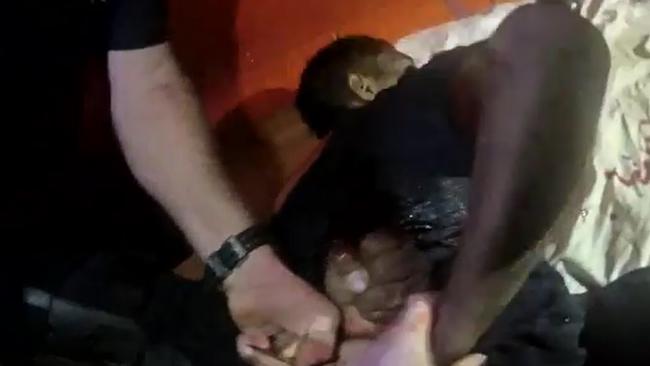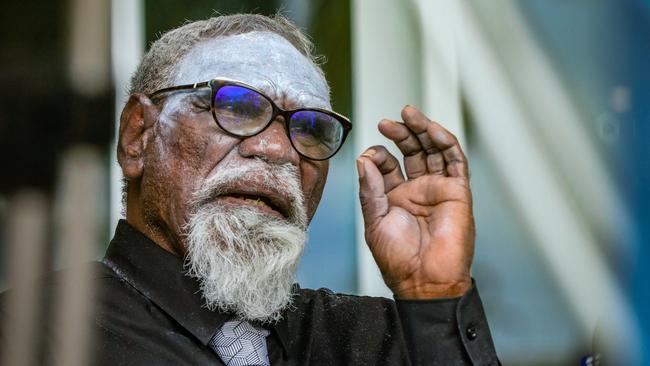Two-point-six seconds.
That’s all that separates what Northern Territory prosecutors say was the legitimate use of force to effect the arrest of an armed man and that most serious of criminal charges – the unlawful taking of a human life.
It’s those 2.6 seconds that have been the focus of jurors in the Supreme Court in Darwin this week after NT Police constable, Zach Rolfe, 30, formally pleaded not guilty to murdering 19-year-old Kumanjayi Walker in the Indigenous community of Yuendumu in 2019.
Mr Walker was pronounced dead on November 9 after Rolfe and his heavily armed Immediate Response Team colleagues descended on the red desert town in the Central Australian outback to arrest the teenager on an outstanding warrant.
He resisted, and in the ensuing struggle, Rolfe shot him three times before he was cuffed and led away to a waiting paddy wagon.
The officers performed first aid but it was already too late, the damage caused as the bullets ripped through Mr Walker’s spleen, kidney and right lung had been done.

THE case against Rolfe is both straight forward and complex.
The prosecution, led by Crown prosecutor Philip Strickland SC, has laid no charge and alleges no wrongdoing over the first of three shots Rolfe fired into Mr Walker’s torso as he wrestled with police, stabbing Rolfe in the shoulder with a pair of surgical scissors.
But just 2.6 seconds later, it’s the second and then the third of those shots fired from Rolfe’s police issue Glock pistol that prosecutors allege constitutes the deliberate killing of an arrest target as he lay pinned to the ground.
In his opening address on Monday, Mr Strickland began to set out the Crown case against Rolfe but was interrupted by Covid-19 protocols that deem anyone who spends four hours or more with a positive case a “close contact”.
(Jurors will sit between 9.30am and 1.15pm each day to avoid a scenario in which all 14 of them, including two reserves, would be forced to undergo seven days self-isolation in the event that any one of them tests positive during the trial.)
When he resumed his address on Tuesday morning, Mr Strickland again played the harrowing footage of Mr Walker’s final moments and their chaotic aftermath.
In it, the officer restraining Mr Walker, Constable Adam Eberl, warns him not to “f*** around” or “I’ll f***ing smash you mate” as the echoes of the final gunshot die out around them.
Then Const Eberl exclaims “Did you – f***”, which Mr Strickland suggested to jurors “may be a reference to the shooting that just occurred”.
“The accused’s response is important,” he told them.
“It’s all good, he was stabbing me, he was stabbing you,” Rolfe is heard saying. “He’s got scissors right here, let go of the scissors.”
In the prosecution’s version of events, it’s that response which could seal Rolfe’s fate.
“Was the accused either, one, referring to Kumanjayi Walker stabbing him, and trying to stab Eberl when they were standing up, that’s before shot one,” Mr Strickland said.
“Or was he referring to what the accused believed he saw, when Eberl and Kumanjayi Walker were on the mattress, that’s before the second and third shot.
“Or did he say those words because he knew that he had gone too far when he fired the second and third shots?
“In other words, when he said those words, ‘He was stabbing me, he was stabbing you’, he knew that the shots were not necessary or reasonable, he knew that everything he’d done was captured on the body-worn video — in short, he said those words in order to justify what he had done.”

WHEN the time came for Rolfe’s barrister, David Edwardson QC, to make his opening address to jurors, he did so as the representative of a “young police officer, charged with the most serious crime known to our law”.
“He was three years out, at the time of the shooting, he was then 28 years of age,” he said.
In setting out the case for the defence, Mr Edwardson touched on what would become a recurring theme of the first week of the hearing, a well-worn phrase, drummed into to all NT Police officers as they complete their basic training – “knife equals gun”.
Rolfe, he said, was “taught, trained and drilled as a member of the Northern Territory police force, that edged weapon equals gun”.
“In other words, where a police officer is confronted with an edged weapon, the appropriate response is to draw your weapon and be prepared to use it,” he said.
“That expression, ‘edged weapon equals gun’ will loom large and ripple through almost all of the (police) witnesses in this case.
“It will be the defence case, through the various prosecution witnesses that are to be called, that Constable Zachary Rolfe did no more than respond in the way in which he had been trained.”
Next, Mr Edwardson laid out the context in which the fatal shooting occurred, the lead up to the tragic collision of two worlds, those of a young, keen cop and a wayward Aboriginal teenager.
On October 29, Kumanjayi Walker had removed an electronic monitoring device from his ankle and absconded from an alcohol rehab centre he was required to attend as part of a sentence handed out by the Alice Springs Local Court.
Eight days later, two other officers, Senior Constables Chris Hand and Lanyon Smith, made an abortive attempt to arrest Mr Walker before he rushed at them, armed with a hatchet and fled into the bush.
It was this incident, Mr Edwardson said, that led senior police to dispatch the expert Immediate Response Team to Yuendumu on November 9, to apprehend a man now considered potentially armed and dangerous.
“Constable Zachary Rolfe and his colleagues from Alice Springs were specifically called in to arrest Walker because they were trained to deal with dangerous arrest targets such as Kumanjayi Walker — in short, the local Yuendumu Police needed help,” he said.
“Members of the jury, Kumanjayi Walker’s criminal history, which is included in the tender bundle that you have now received, and the axe incident on 6 November, 2019, is relevant because it shows that the deceased was of a violent disposition and that he was, in truth, the aggressor, by deliberately deploying the scissors against Constable Rolfe and on the defence case, subsequently against Constable Eberl.
“It shows that he had the propensity to act in a violent way and indeed, that violent disposition manifested itself such that Zachary Rolfe was entitled to defend himself and defend Constable Eberl in the manner he did, notwithstanding the resulting tragic death of Kumanjayi Walker.”

WHEN the confronting footage of Kumanjayi Walker’s death was played in the Supreme Court this week, for many of the slain teenager’s family members, it was the first time they had borne witness to his violent end.
Speaking outside court, Warlpiri elder Linsday Japangardi Williams said the community had remained in mourning since Mr Walker’s death more than two years ago while awaiting the trial.
“We have stayed in sorry business, that means we are still grieving the loss of our loved one, Kumanjayi Walker, who was taken away from us at a very young age,” he said, the traditional white paint of grief adorning his face.
“During these two years, some of our family members have passed away, we have waited a long time, we’ve travelled a long way, we want justice for our family.”
Fellow elder, Ned Jampijinpa Hargraves, said many more of Mr Walker’s family members would have liked to attend if Covid restrictions and flooding had not kept them from travelling from Yuendumu.
“It’s been two years, it’s been two solid years, two much, we are still hurting,” he said.
“We want to see justice, that’s what we want to see.”
On the other side of the ledger, NT Police Association president, Paul McCue, who has been a constant presence at Rolfe’s side throughout the proceedings, told reporters the union was looking forward to “ultimately, seeing justice prevail”.
“Obviously from a Police Association perspective, nothing changes for us, we’ll continue to provide ongoing support to Zach and his entire family,” he said.
“Police across the country have provided a lot of support from all of my colleagues, through every police union, association across the country.”

LATER in the week, Supreme Court Justice John Burns released the harrowing footage of an axe wielding Kumanjayi Walker advancing on police as they tried to arrest him on an outstanding warrant three days before his death.
Those police officers, Senior Constables Chris Hand and Lanyon Smith, both then took the stand to relive the “truly terrifying experience”.
The officers had been tasked with arresting Mr Walker on an outstanding warrant when they confronted him at house 577 in Yuendumu on November 6, 2019.
Under questioning from Crown prosecutor Philip Strickland SC, Const Hand said he was armed with his police issue Glock at the time but did not remove it from its holster.
“One of the four operational safety principles with firearms is if you draw your firearm, you never want the muzzle to cover, or point at, anything you’re not willing to destroy,” he said.
“Also it escalates the situation, obviously we’re trying to de-escalate the situation and drawing a firearm would be escalating it and then it’s harder to de-escalate.”
Mr Strickland asked Const Hand what the phrase “knife equals gun” meant in terms of his police training and he said it meant that “you could draw your firearm if you want to”.
“Because a subject can effectively stab you with a knife quite quickly, can cover a lot of distance,” he said.
“It depends on the situation that you’re in, the person who’s holding the weapon, their intent, what you think they intend is and who else is around also.”
But Const Hand also agreed with defence counsel, David Edwardson QC, that “things had changed very significantly” after the axe incident, and if an offender was armed with an edged weapon and was within six metres, officers were “entitled to pull your firearm”.
“And if you pull your firearm, you’ve got to be prepared to pull the trigger?” Mr Edwardson asked.
“You’re taught to shoot to the centre mass of the body? You want to (incapacitate) the threat, stop them in their tracks?”
“Yes,” Const Hand replied.
Const Smith, who had been stationed in Yuendumu since 2017, said he chose not to draw his weapon when confronted with the axe for a number of reasons, including the proximity of other civilians and his knowledge of Warlpiri culture.
He said Warlpiri men were known to “brandish nulla-nullas, sticks, trampoline poles” but “a lot of it is for show”.
“To show ‘I would want to hurt this person but because police are here I can’t’ but in their minds, they’re trying to impress upon their family that they’re a strong person,” he said.
“Given that his partner and his mother-in-law was in the house, that’s what I was thinking also.”
But under cross examination by Mr Edwardson, Const Smith agreed that had Mr Walker actually used the axe to more than threaten the officers his “response could have been quite different”.
In other body worn camera footage played during the cross examination, Const Smith is heard saying he was “stuck in a corner” and “begging for mercy” during the incident and he agreed with Mr Edwardson that he had seen “(his) life flashing before (his) eyes”.
Rolfe has pleaded not guilty to all charges and the trial continues in Darwin on Monday.

Youths face assault charges over alleged Katherine cafe robbery
Two males youths, aged 18 and 14 have been arrested in relation to two incidents of aggravated robbery and burglary at a Katherine café late Tuesday night and early Wednesday morning.
Shark scare closes popular Darwin swimming spot
A shark scare has forced the closure of a popular Darwin swimming spot.